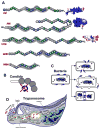Neuropeptides: keeping the balance between pathogen immunity and immune tolerance
- PMID: 20399708
- PMCID: PMC3417345
- DOI: 10.1016/j.coph.2010.03.003
Neuropeptides: keeping the balance between pathogen immunity and immune tolerance
Abstract
Various neuropeptides have emerged recently as potent immunomodulatory factors with potential for their therapeutic use in immune disorders. Here we highlight the most recent data relevant in the field and we offer our opinion on how neuropeptide therapy might impact clinical immune diseases, and the challenges in this field that must be overcome before achieving medical progress. We also review recent reports describing the antimicrobial effects showed by some neuropeptides and the therapeutic, physiological, and evolutionary consequences of this new finding. Finally, we discuss how a physiologically functional neuropeptide system contributes to general health and how neuropeptides educate our immune system to be tolerant.
Copyright 2010 Elsevier Ltd. All rights reserved.
Figures


Similar articles
-
Neuropeptides as therapeutic approach to autoimmune diseases.Curr Pharm Des. 2010;16(28):3158-72. doi: 10.2174/138161210793292465. Curr Pharm Des. 2010. PMID: 20687881 Review.
-
Anti-inflammatory neuropeptides: a new class of endogenous immunoregulatory agents.Brain Behav Immun. 2008 Nov;22(8):1146-51. doi: 10.1016/j.bbi.2008.06.001. Epub 2008 Jun 14. Brain Behav Immun. 2008. PMID: 18598752 Free PMC article. Review.
-
Endogenous anti-inflammatory neuropeptides and pro-resolving lipid mediators: a new therapeutic approach for immune disorders.J Cell Mol Med. 2008 Oct;12(5B):1830-47. doi: 10.1111/j.1582-4934.2008.00387.x. Epub 2008 Jun 28. J Cell Mol Med. 2008. PMID: 18554314 Free PMC article. Review.
-
Neuropeptides as pleiotropic modulators of the immune response.Neuroendocrinology. 2011;94(2):89-100. doi: 10.1159/000328636. Epub 2011 Jul 7. Neuroendocrinology. 2011. PMID: 21734355 Review.
-
Anti-inflammatory neuropeptide receptors: new therapeutic targets for immune disorders?Trends Pharmacol Sci. 2007 Sep;28(9):482-91. doi: 10.1016/j.tips.2007.07.001. Epub 2007 Aug 3. Trends Pharmacol Sci. 2007. PMID: 17688953 Review.
Cited by
-
Vasoactive intestinal peptide/vasoactive intestinal peptide receptor relative expression in salivary glands as one endogenous modulator of acinar cell apoptosis in a murine model of Sjögren's syndrome.Clin Exp Immunol. 2011 Dec;166(3):309-16. doi: 10.1111/j.1365-2249.2011.04478.x. Clin Exp Immunol. 2011. PMID: 22059987 Free PMC article.
-
Biomarkers predicting a need for intensive treatment in patients with early arthritis.Curr Pharm Des. 2015;21(2):170-81. doi: 10.2174/1381612820666140825123104. Curr Pharm Des. 2015. PMID: 25163741 Free PMC article. Review.
-
Sniffer restricts arboviral brain infections by regulating ROS levels and protecting blood-brain barrier integrity in Drosophila and mosquitoes.PLoS Pathog. 2024 Dec 16;20(12):e1012797. doi: 10.1371/journal.ppat.1012797. eCollection 2024 Dec. PLoS Pathog. 2024. PMID: 39680616 Free PMC article.
-
Immunomodulatory role of vasoactive intestinal peptide and ghrelin in Oncorhynchus mykiss.Heliyon. 2023 Dec 2;9(12):e23215. doi: 10.1016/j.heliyon.2023.e23215. eCollection 2023 Dec. Heliyon. 2023. PMID: 38149209 Free PMC article.
-
Inflammation and the nervous system: the connection in the cornea in patients with infectious keratitis.Invest Ophthalmol Vis Sci. 2011 Jul 11;52(8):5136-43. doi: 10.1167/iovs.10-7048. Invest Ophthalmol Vis Sci. 2011. PMID: 21460259 Free PMC article.
References
-
- Gonzalez-Rey E, Delgado M. Anti-inflammatory neuropeptide receptors: new therapeutic targets for immune disorders? Trends Pharmacol Sci. 2007;28:482–491. - PubMed
-
- Gonzalez-Rey E, Chorny A, Delgado M. Regulation of immune tolerance by anti-inflammatory neuropeptides. Nat Rev Immunol. 2007;7:52–63. - PubMed
-
This is a comprehensive review describing the effects of some anti-inflammatory neuropeptides, and the cellular and molecular mechanisms involved, on the induction of immune tolerance.
-
- Lühder F, Lee DH, Gold R, Stegbauer J, Linker RA. Small but powerful: short peptide hormones and their role in autoimmune inflammation. J Neuroimmunol. 2009;217:1–7. - PubMed
Publication types
MeSH terms
Substances
Grants and funding
LinkOut - more resources
Full Text Sources
Medical

